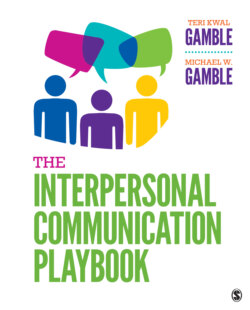Читать книгу The Interpersonal Communication Playbook - Teri Kwal Gamble - Страница 118
На сайте Литреса книга снята с продажи.
Selection
ОглавлениеAlthough our senses can process approximately 5 million bits of data every second, our brains can handle only about 500 bits per second.21 Because of our inability to perceive everything, we are compelled to be selective about stimuli.22 As a result, we focus on certain cues and ignore others. Figure 3.1 illustrates the process of perception in action.
As you read this chapter, stop and look around you. What do you see? What captures your attention? Is it the hum of the refrigerator, the feel of your chair, the color of the walls, or voices coming from another location? Consciously turn your attention to something different. What did you fail to notice initially that now makes an impression on you?
Figure 3.1 The Perception Process
Since we can attend to only a limited number of stimuli, we choose which people, situations, or events to perceive. When we interact with others, some of us focus on appearance, others on the strength of a handshake, and still others on the sound of the voice or the look in the person’s eyes. We direct our attention to certain qualities and not others. Multiple factors influence what we pay attention to, what enters our awareness and what exists unobserved and unnoticed.
Usually we focus on a stimulus that is more intense than others or that reflects our motives or interest more than others. For example, we pay attention to a loud noise that disrupts our concentration. Likewise, we overhear a conversation near us in a diner if the two people are speaking about a topic that concerns us. Our interests influence our perceptions, as do our motives. When, for example, we are concerned with our financial situation, we notice more information about how to save money. When we are hungry, we become more aware of food establishments, or we notice the aroma of what someone else is eating. When we are late for an appointment, we might run right past a close friend without even realizing it.
According to psychologist Herbert Simon, “A wealth of information creates a poverty of attention.”23 When we direct our attention to some stimuli, while choosing to ignore others, we demonstrate selective perception. What are the specific cues you focus on when first meeting someone? What do you look for? What do you listen for? Three components of the perceptual process provide answers to these questions:
Selective exposure is our preference for people and messages that confirm our existing beliefs, values, or attitudes, such as paying attention to messages delivered by a candidate we are supporting.
Selective attention is the means by which we focus on certain cues but ignore others, such as not noticing the look of disgust on the face of someone we like.
Selective retention is the practice by which we recall things that reinforce our thinking and forget things we find objectionable, such as recalling positive qualities of people we like and negative qualities of people we dislike.24
In using any of these, we may bias the perceptual process of selection and end up with distorted views of people or events. For example, think about a relationship you once shared but ended. Once you made the “end-it” decision, did you start to notice more about the person that you disliked? This is known as the horn effect, which occurs when our perception tends toward the flaws of a person or thing. Compare this phenomenon to what happens when you decide to take a personal relationship to a more serious level. Once you have made this kind of decision, instead of perceiving what is negative about the other person, you are more likely to perceive additional things that you like. The reverse of the horn effect is known as the halo effect.
Selective perception helps us create a somewhat limited but more coherent and personally meaningful picture of the world—a picture that conforms to our beliefs, expectations, and convictions.25
